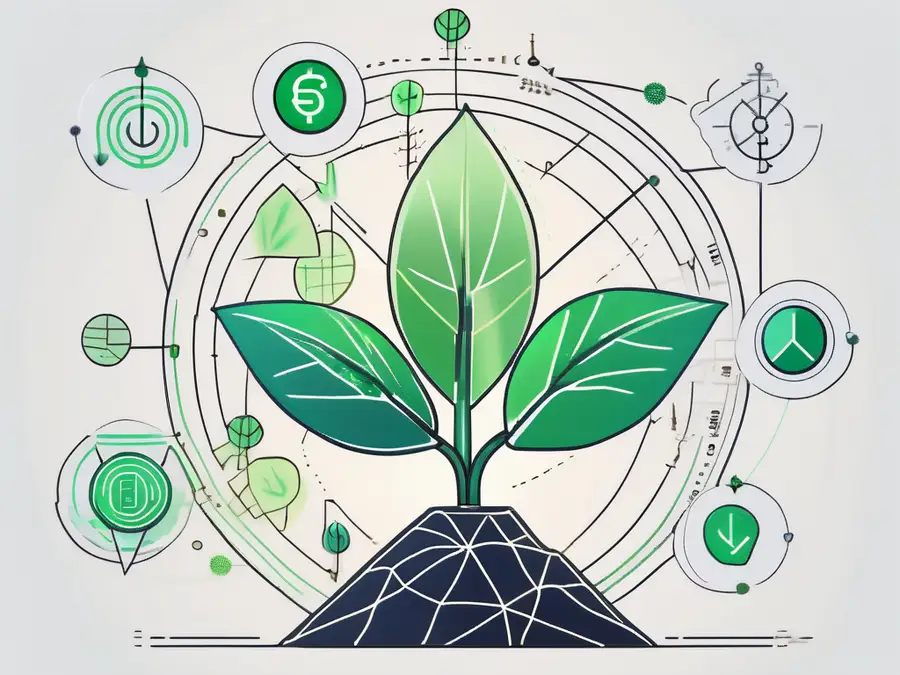The Concept of Real Yield in Decentralized Finance (DeFi)

Decentralized Finance, also known as DeFi, has been making waves in the world of finance. It offers a new way of managing and investing money that is decentralized, transparent, and open to anyone with an internet connection. One important concept in DeFi is the concept of real yield. In this article, we will dive deep into the concept of real yield in DeFi, understand its significance, and explore how it is calculated.
Understanding the Basics of Decentralized Finance
Before we delve into the specifics of real yield, let's take a moment to understand the basics of DeFi. In simple terms, DeFi refers to a system in which financial transactions are conducted through decentralized platforms, without the need for intermediaries such as banks or other financial institutions. This allows for greater accessibility and transparency, as well as the potential for higher returns compared to traditional financial systems.
Decentralized Finance is a concept that aims to transform traditional financial systems through the use of blockchain technology and smart contracts. By removing intermediaries, DeFi allows users to have greater control over their financial transactions and investments. This opens up opportunities for individuals who may have previously been excluded from traditional financial systems.
One of the key advantages of DeFi is its ability to provide financial services to the unbanked and underbanked populations. In many parts of the world, traditional banking services are limited or inaccessible, leaving millions of people without access to basic financial tools. DeFi platforms, on the other hand, can be accessed by anyone with an internet connection and a smartphone, making financial services more inclusive and empowering individuals to take control of their own financial futures.
Another important aspect of DeFi is its potential for higher returns compared to traditional financial systems. In traditional banking, interest rates on savings accounts are often low, and investment opportunities may be limited. DeFi, on the other hand, offers a wide range of investment options, including lending and borrowing platforms, decentralized exchanges, and yield farming protocols. These platforms often provide higher interest rates and the potential for greater returns on investments, attracting investors who are looking to grow their wealth.
Key Components of DeFi
There are several key components that make up the DeFi ecosystem. These include decentralized exchanges, lending and borrowing platforms, stablecoins, and yield farming protocols. Each of these components plays a crucial role in enabling decentralized finance and contributing to the overall growth of the ecosystem.
Decentralized exchanges (DEXs) are platforms that allow users to trade cryptocurrencies directly with each other, without the need for a centralized intermediary. These exchanges operate on blockchain technology and use smart contracts to facilitate peer-to-peer transactions. By eliminating the need for a central authority, DEXs offer greater privacy, security, and control over assets.
Lending and borrowing platforms are another important component of DeFi. These platforms allow users to lend their cryptocurrencies to others and earn interest on their holdings. Borrowers, on the other hand, can use their crypto assets as collateral to secure loans. This enables individuals to access credit without the need for a traditional bank, opening up new opportunities for financial inclusion and economic empowerment.
Stablecoins are cryptocurrencies that are designed to maintain a stable value, often pegged to a fiat currency like the US dollar. These digital assets provide a way to store value and make transactions without the volatility commonly associated with other cryptocurrencies. Stablecoins play a crucial role in DeFi by providing a stable unit of account and a medium of exchange within the decentralized ecosystem.
Yield farming protocols, also known as liquidity mining, are a way for users to earn rewards by providing liquidity to decentralized platforms. Users can lock up their cryptocurrencies in smart contracts and receive tokens in return. These tokens often represent a share of the platform's revenue or governance rights. Yield farming has become a popular way for investors to earn passive income and participate in the growth of DeFi projects.
In conclusion, DeFi is a revolutionary concept that aims to transform traditional financial systems by leveraging blockchain technology and smart contracts. By removing intermediaries, DeFi offers greater accessibility, transparency, and potential for higher returns compared to traditional financial systems. With its key components such as decentralized exchanges, lending and borrowing platforms, stablecoins, and yield farming protocols, DeFi is paving the way for a more inclusive and decentralized financial future.
The Role of Yield in DeFi
Yield is at the heart of DeFi. In simple terms, yield refers to the return on an investment or the profit generated from holding a particular asset. In the context of DeFi, yield represents the rewards and returns that individuals can earn by participating in various DeFi protocols and activities.
Defining Yield in DeFi
Yield in DeFi can take various forms, including interest earned from lending and borrowing, fees generated from liquidity provision, and rewards for participating in yield farming strategies. These yields can be earned by users who contribute their assets to the DeFi ecosystem, thus providing liquidity or capital for various DeFi protocols.
Importance of Yield in DeFi Investments
Yield plays a crucial role in attracting users to invest in and participate in DeFi. The potential for high yields has been one of the driving factors behind the rapid growth of the DeFi ecosystem. However, it is essential to understand that the concept of yield in DeFi is not solely about the numerical return on investment; it also involves considering the risks and rewards associated with different protocols and strategies.
Introduction to Real Yield
Now that we have a basic understanding of yield in DeFi, let's explore the concept of real yield. Real yield refers to the yield adjusted for inflation and other external factors that can impact the purchasing power of an asset's return.
Real Yield vs Nominal Yield
Nominal yield is the basic, unadjusted yield calculated based on the stated rate of return. On the other hand, real yield takes into account the impact of inflation and other factors to provide a more accurate picture of the actual purchasing power of the returns generated by an investment.
Factors Influencing Real Yield
Several factors can influence the real yield of an investment in DeFi. These include inflation rates, currency fluctuations, market conditions, and external economic factors. It is crucial for investors to consider these factors when evaluating the potential real yield of their investments in DeFi.
Calculating Real Yield in DeFi
Calculating real yield in DeFi involves a multi-step process that requires careful consideration of various variables. Let's walk through the general steps involved in calculating real yield in DeFi.
Understanding the Calculation Process
The calculation process for real yield in DeFi can vary depending on the specific investment or protocol. However, in general, it involves taking the nominal yield and adjusting it for inflation to determine the real yield.
Variables in Real Yield Calculation
When calculating real yield, several variables need to be taken into account. These include the nominal yield, inflation rate, currency exchange rates, and any other factors that may impact the purchasing power of the investment's return.
Risks and Rewards of Real Yield in DeFi
While pursuing real yield in DeFi can offer attractive opportunities, it is essential to be aware of the potential risks involved. Let's explore some of the potential risks and rewards associated with pursuing real yield in DeFi.
Potential Risks in Pursuing Real Yield
One of the primary risks of pursuing real yield in DeFi is the potential for smart contract vulnerabilities or protocol exploits. As the DeFi ecosystem is relatively new and rapidly evolving, there may be certain risks associated with the technology that users need to be cautious about.
Rewards and Opportunities in Real Yield
Despite the risks, pursuing real yield in DeFi can offer significant rewards and opportunities. By carefully vetting protocols, staying informed about market trends, and diversifying investments, individuals can potentially benefit from the high yields and opportunities available in the DeFi ecosystem.
Personal advice: As an expert in DeFi, I would recommend being vigilant and thoroughly researching any protocol or investment opportunity before committing your funds. It is crucial to understand the risks involved and to only invest what you can afford to lose. Additionally, staying updated with the latest developments in the DeFi space and seeking advice from experienced individuals can help navigate the rapidly changing landscape of DeFi investments.
FAQ
What is DeFi?
Decentralized Finance, or DeFi, refers to a system in which financial transactions are conducted through decentralized platforms, without intermediaries such as banks. It offers greater accessibility, transparency, and potential for higher returns compared to traditional financial systems.
What is real yield?
Real yield refers to the yield adjusted for inflation and other external factors that can impact the purchasing power of an asset's return.
How is real yield calculated in DeFi?
The calculation of real yield in DeFi involves taking the nominal yield, adjusting it for inflation, and considering other variables such as currency exchange rates.
What are the risks of pursuing real yield in DeFi?
The potential risks of pursuing real yield in DeFi include smart contract vulnerabilities, protocol exploits, and the fast-paced nature of the DeFi ecosystem. It is essential to conduct thorough research and exercise caution when participating in DeFi investments.
What are the rewards and opportunities in pursuing real yield in DeFi?
Despite the risks, pursuing real yield in DeFi can offer significant rewards and opportunities. By carefully vetting protocols, staying informed, and diversifying investments, individuals can potentially benefit from the high yields and opportunities available in the DeFi ecosystem.
In conclusion, real yield is a crucial concept in decentralized finance that allows investors to make informed decisions about their investments and navigate the ever-evolving landscape of DeFi. By understanding the basics of DeFi, the role of yield, and calculating real yield, individuals can take advantage of the rewards and opportunities while managing the associated risks.
Ready to harness the power of real yield in DeFi? Look no further than Morpher, the revolutionary trading platform that's changing the game with zero fees, infinite liquidity, and a non-custodial wallet for your security. Whether you're interested in stocks, cryptocurrencies, forex, or even niche markets like NFTs, Morpher's unique trading experience on the Ethereum Blockchain is designed to maximize your investment opportunities. Take advantage of fractional investing, short selling without interest fees, and up to 10x leverage to amplify your trades. Sign Up and Get Your Free Sign Up Bonus today to start trading with Morpher and explore the full potential of DeFi's real yield.

Disclaimer: All investments involve risk, and the past performance of a security, industry, sector, market, financial product, trading strategy, or individual’s trading does not guarantee future results or returns. Investors are fully responsible for any investment decisions they make. Such decisions should be based solely on an evaluation of their financial circumstances, investment objectives, risk tolerance, and liquidity needs. This post does not constitute investment advice.

Painless trading for everyone
Hundreds of markets all in one place - Apple, Bitcoin, Gold, Watches, NFTs, Sneakers and so much more.

Painless trading for everyone
Hundreds of markets all in one place - Apple, Bitcoin, Gold, Watches, NFTs, Sneakers and so much more.









